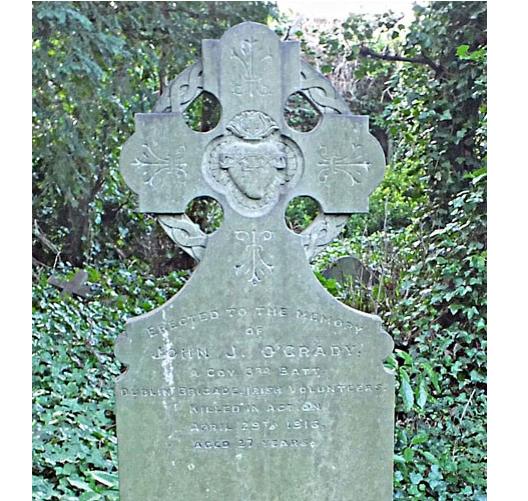 1916 Rebel John J O’Grady Buried in St James’s Graveyard By Sean J Murphy
1916 Rebel John J O’Grady Buried in St James’s Graveyard By Sean J Murphy
Gravestone of Volunteer John J O’Grady in St James’s Graveyard Having ceased to be used for religious purposes in the 1960s and lain vacant in recent years, the old St James’s Protestant Church in James’s Street is being brought back to life. Dr Pearse Lyons of Alltech, whose grandfather John Hubert Lyons is buried in the graveyard behind the church, is converting the building into a craft distillery and visitor centre, due for opening next year. Already the formerly blocked-up church windows have been restored, while Liberties residents will have noticed the eye-catching replacement glass spire put in place recently. In the course of carrying out historical research for the project I discovered that a 1916 rebel who died in action is buried in the graveyard.
As we commemorate the centenary of the Rising it is appropriate to recall his story. Despite being close to the South Dublin Union, now the St James’s Hospital campus, where there was fierce fighting during the 1916 Rising, St James’s Graveyard does not have many burials associated with that rebellion. Indeed the Church of Ireland burial register for St James’s has some blank pages around the end of April 1916, indicating that a mass burial may have been anticipated. As it turned out, the major commercial cemeteries, in particular Glasnevin, were well able to accommodate the hundreds of fatalities in the city.
However, at least one casualty of 1916 was buried in St James’s Graveyard. This is John James O’Grady, a member of A Company, 3rd Battalion, Dublin Brigade of the Irish Volunteers, who was killed in action on 29 April 1916. A fine memorial stone, pictured above, was erected over his grave, probably by his family, and is still in place in the graveyard. O’Grady was a keen cyclist and used this skill during the 1916 Rising. Serving with the rebel garrison in Jacob’s Biscuit Factory, O’Grady was one of a party of fourteen armed cyclists sent out on a sortie by Commandant Thomas MacDonagh in order to assist Éamonn de Valera’s garrison in Boland’s Mills. This operation occurred on Saturday 29 April, on what was to be the last day of the Rising, and would prove fatal for O’Grady. As the cyclists retreated under fire from the British Army, O’Grady was shot in the stomach at York Street, brought first back to Jacob’s and then to the nearby Adelaide Hospital, where he soon expired.
John James O’Grady, who worked as a crane driver, was aged 27 when he died and was the son of Charles O’Grady, a bookbinder, and Ellen Murray. The O’Grady family is listed in the 1911 Census as living in 1 St Nicholas Place, with John James the eldest child, followed by his sister Kathleen and brothers Charles, Francis and Joseph. Charles, who also fought in the Rising and was based in Roe’s Distillery, recalled in his Bureau of Military History Witness Statement that he first heard the news of his brother’s death from a policeman’s daughter. John had married Josephine Gray in August 1915, just eight months before his death, and his widow later succeeded in obtaining a state pension. For further information on Volunteer John J O’Grady see Ray Bateson, They Died by Pearse’s Side, and Mick O’Farrell, The 1916 Diaries.









Permission to reprint story of Volunteer’s grave on history page?
Certainly. By all means.